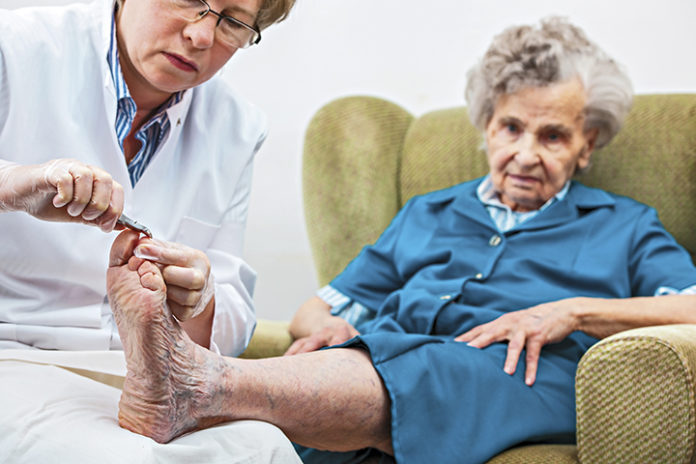By Melanie Ramos
Why should you obtain the services of a certified foot care nurse instead of going to a nail salon or spa, or from someone who does foot care on the side and can do the work at a discounted rate?
Foot care is an essential service that most people don’t think about until they’re in a lot of pain and discomfort.
Foot care is an essential service that most people don’t think about until they’re in a lot of pain and discomfort.
To help family caregivers gain a better understanding of the importance of foot care and foot health, Elizz spoke to Ian, a longtime registered nurse who specializes in foot care with Saint Elizabeth, the company that powers Elizz.
Ian graduated from nursing school in 1983 and worked for many years in hospitals and as a visiting home care nurse. After taking some time to care for aging parents with cancer, he worked in a coronary care unit until leaving hospital nursing. In 2014, he began community care again in the specialty role of the Foot Care Nurse.
In this Elizz article, Ian will share some of his insights about the value of certified foot care nurses.
Why use a certified foot care nurse?
Foot care nurses are highly educated and medically trained
Foot care nurses are registered nurses (RNs), licensed practical nurses (LPNs)/registered practical nurses (RPNs) and personal support workers (PSWs) that are trained and certified in this practice. The difference is that PSWs are licensed to provide basic foot care while RNs and LPNs/RPNs can provide advanced foot care to their clients.
In order to protect the public, all foot care nurses must be certified by their provincial nursing college and a member in good standing. Ian holds a current Certificate of Competence with the College of Nurses of Ontario (CNO), which is a requirement for all nurses in Ontario. To specialize in foot care nursing, Ian also took additional courses specifically related to foot care.
Foot care nurses provide a professional nursing service, not pedicures
As a certified foot care nurse in Ontario, Ian has a legal responsibility to report any medical issues he finds to his client and/or family caregiver to ensure that they are aware of the situation and that there is follow-up care.
Nail technicians and spa workers have undeclared amounts of training for the work that they do but unless the person is an RN, an LPN/RPN, or a trained PSW, they are not health care professionals or, in the case of a PSW, a health care worker, nor do they have any professional college that would hold them to any standard of practice. Basically, they are not trained to recognize or care for a health problem or provide health teaching to the client.
And, because not all provinces require nail technicians to be licensed, consumers may be seeing someone who is not up to speed on all of the latest safety and foot care best practice guidelines.
Certified foot care nurses are trained to do the following services:
- Callous removal and/or corn removal
- Trim toenails for clients who may have complications that make it unsafe or impossible for them to do it themselves (for example: nerve damage due to diabetes, dementia, arthritis, etc.)
- Provide education for clients and caregivers regarding ongoing foot care, selecting proper-fitting shoes, etc.
- Spot potential issues and take appropriate action before infection sets in or the pain gets worse
Certified foot care nurses have the right tools for the job
When asked why only certified foot care nurses can provide foot care, Ian explains that they have the proper foot care tools on-hand to do the job of caring for feet (including foot care for seniors). When he’s on the job, Ian has nine sets of foot care tools that he relies on. Each tool set includes:
- Foot file
- Corn remover (which Ian points out isn’t a tool he ever uses as it can cause more injury)
- Two nail files
- Blacks file, which is used to sand down nail edges to trim involuted nails and help to prevent ingrown toenails
- Cutting pliers
- Nipper
- Scissors
- Regular nail clippers
In addition, he also uses a Dremel power tool and sanding bits for mycotic toenail treatment. According to Ian, regular toenail clippers aren’t strong enough to cut through thickened toenails that have succumbed to fungus. The only option to trimming mycotic toenails is to sand them down.
These foot care tools are not normally part of hospital or clinic supply carts, and regular nurses don’t carry them around in their kits. As a certified foot care nurse, Ian has invested in tools of the trade that are made with high quality German steel and are backed by lifetime warranties to ensure that his clients receive the best foot care possible.
If the person in your care has foot care issues, it’s worth having the matter assessed and cared for by someone who not only has the skills, training, and equipment to do the job properly, but also has your best interests (and those of the person in your care) in mind. Call Elizz toll free at 1-855-275-3549 to inquire about our foot care services for you or for the person you are caring for.
Melanie Ramos is an Elizz Editor. This article is reprinted from elizz.com with permission.


